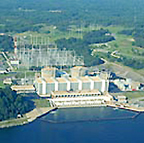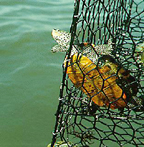|
||
Way DownstreamIn Anne Arundel County, beaches and waterfront areas fared relatively well in a recent water quality report, with potentially dangerous bacteria never exceeding allowable limits at 64 beaches last year. But the Natural Resources Defense Counsel analysis of state samples said several locations — Annapolis Landing, Severn Grove and Town Point — had readings too high between one-third and one-half of the time. In Calvert, the most frequent over-limit levels were reported at Seahorse Beach in Lusby, Brownie’s Beach in Chesapeake Beach and the public beach at North Beach … In Calvert County, believe it or not, the Board of County Commissioners has authorized a big-time Throughout Maryland, large terrapins gain immunity to harvesting, while smaller terrapins, with shells four to seven inches long, become fair game. New commercial harvesting regulations also limit the harvest season to three months and require all catches be reported. These rules just passed by DNR’s Administrative, Executive and Legislative Review Committee are supposed to conserve Maryland’s diamondback In the Chesapeake Bay watershed, state biologists have a plan to help out our forgotten ailing species, the American eel. In Queen Anne’s County, they’ve built an eelway to help these young eels, elvers, negotiate one of many dams blocking reproduction of these valuable, slithering wonders … Our Creature Feature also comes from Chesapeake Bay, where there’s a reason that biologists are a tad concerned about the second discovery of a Chinese mitten crab. These long-legged critters with the hairy claws are invaders that would bring us nothing but trouble if they arrive in great numbers. Besides competing with our revered blue crab and eating juvenile fish, they’re regarded by fishermen as notorious bait thieves. Yes, they’re edible, but one Web site carries a warning that they pose a health threat because they are hosts for another nasty invader, the Oriental lung fluke. |
||
|
|
||
|
© COPYRIGHT 2004 by New Bay Enterprises, Inc. All rights reserved.
|



 tax break in a deal to try to add a third reactor at Calvert Cliffs Nuclear Power plant — in a county that has one evacuation corridor. The giveaways from taxpayers in planning for new nuclear power are mind-boggling: An energy bill passed by Congress last year authorized as much as $6 billion in subsidies for the nuclear industry …
tax break in a deal to try to add a third reactor at Calvert Cliffs Nuclear Power plant — in a county that has one evacuation corridor. The giveaways from taxpayers in planning for new nuclear power are mind-boggling: An energy bill passed by Congress last year authorized as much as $6 billion in subsidies for the nuclear industry … terrapin population by sparing larger, reproducing females from the food market, to buy time for a terrapin population survey, by the U. S. Geological Survey. “The DNR proposal could actually accelerate the demise of terrapins in the Chesapeake,” wrote Terrapin Institute founder Marguerite Whilden just before the rules were passed [Bay Weekly, Vol. xiv, No 28: July 13] …
terrapin population by sparing larger, reproducing females from the food market, to buy time for a terrapin population survey, by the U. S. Geological Survey. “The DNR proposal could actually accelerate the demise of terrapins in the Chesapeake,” wrote Terrapin Institute founder Marguerite Whilden just before the rules were passed [Bay Weekly, Vol. xiv, No 28: July 13] …